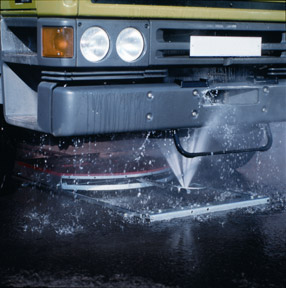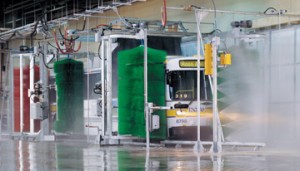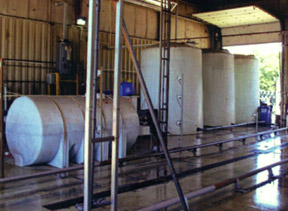Bus wash innovations add efficiencies to the chore
By David Hubbard

A clean coach is just good business. But the burden of bus washing often falls to maintenance garage managers not so focused on the wash bay. Bus washing merits as much consideration any other maintenance detail.
Going clean is the easiest and most cost effective way to attract and retain the best customers. A washed vehicle encourages drivers to drive safely and maintain the vehicle. Technicians are prone to take more time under a clean vehicle to perform the necessary preventative maintenance. Regular washing with an effective system extends the life of the bus and helps hold its value.
Where a bus wash system represents a significant capital investment from initial planning to final installation, most companies rely on only one wash setup in one wash bay to clean all the vehicles in a mixed fleet from standard size bus and coaches to paratransit shuttles. The reasons for choosing the one best system over another run a gamut of reasons — space in the facility site, fleet size, allotted time and labor, water usage, waste water reclamation and environmental regulations. The key is to choose correctly.
Innovative bus wash companies and manufacturers are working to make the chore of bus washing easier to afford, easier to manage, faster and less labor intensive, less abrasive to the rolling stock and kinder to the environment.
The efficiencies in new bus washing systems continue to lower the cost per bus in terms of chemicals and water required. Above ground reclamation systems have improved the issues with cleanliness in the wash bay with the system operating similar to a filtered pool.

The challenge of mixed fleets
Ross & White Company, Cary, IL, says the newest bus wash challenge for transit agencies is the recent proliferation of buses of every model and size coming through one system.
“The wash system once accommodated only one standard box-shaped transit bus, now it must have the flexibility to handle small body-on-chassis paratransit buses, articulated vehicles and a variety of shuttles,” says company principle Jeff Ross. “Though a brush system is still the best way to go, these mixed fleets require the incorporation of high pressure spray technology.”
The company says it meets this challenge with highly adaptable hybrid bus wash systems that combine brush and touchless spray technology. Technicians can easily modify the brushes and sprays for every type of vehicle in the fleet.
“A brush system by itself may be the most economical,” says Ross. “But the combination of brush and spray cleans evenly and gets into areas where brushes alone cannot reach.”

Out of sight still in mind
Cleaning Equipment Unlimited, Northridge, CA, is the official U.S. distributor for Chassijet, an automatic, programmable chassis cleaning system manufactured in the U.K. The company says a clean bus creates a strong image, but the underside of the vehicle requires as much attention in terms of safety and longevity. Chassijet president Rick Ray says from a maintenance perspective the dirt and grime that collects out of sight is far more damaging.
The Chassijet provides automatic press-button cleaning of the underside of all over-the-road vehicles. The programmable cleaning trolley travels on its own set of rails under the stationary vehicle as the high-pressure 2000 psi oscillating, sweeping spray jets do the cleaning.
The system memory accommodates up to 40 programs entered at the time of manufacture or during the installation process. A technician can make program additions and alterations at any time using the operator keypad or manually select the required function.
Chassijet says the various programs adjust and coordinate wash speed, water temperature, detergent injection and foam application for any combination of vehicle lengths. Dwell periods allow the system to concentrate on heavily soiled areas.
The ChassiJet trolley rails bolt directly to the floor suspended over an existing inspection pit. Or the system can fit to a specially constructed ramp. Available options include a hot water module, detergent injection, pre-wash foam application, pressure reduction, frost protection, manual hand lance and water reclamation
Outsource the wash system
Where bus wash companies typically manufacturer and market the equipment. DyChem International, Salt Lake City, UT, installs and maintains its proprietary wash system for the opportunity to supply the cleaning products. DyChem says the business model is essentially an outsourcing process akin to a long-term lease arrangement. The company says the investment by the fleet owner is minimal and maintenance-free. The basic requirements are an available wash bay on the premises with adequate water, power and drainage.
The process consists of a fast-acting two-phase application system using safe and harmless biodegradable chemicals that DyChem says thoroughly flushes away under high pressure rinsing. The first step is a low pH product applied to the entire vehicle. An alkaline product then neutralizes the low pH creating the chemical shock that releases the statically held road film and dirt from the surfaces.
The simple drive-through spray system washes a vehicle in approximately 60 seconds.
Jonathon Howe, DyChem vice president, sales and marketing, says the typical DyChem contract covers between 300 and 400 bus washes per month for a fleet of 75 to 100 vehicles.
“We use this as a benchmark for the size fleet necessary to invest in a partnership with DyChem for the purchase the cleaning chemicals from DyChem,” says Howe. “However, we can offer a longer contract for smaller fleets.”
Through its nationwide network of representatives, DyChem provides all maintenance and repairs due to normal use for the duration of the partnership, limiting customer expense to actual product usage.
The extra care given to the exterior surfaces of buses and motorcoaches has become a greater concern in the advent of sophisticated bus-wrap advertising, and transportation companies wanting to sport a more upscale appearance. BR
